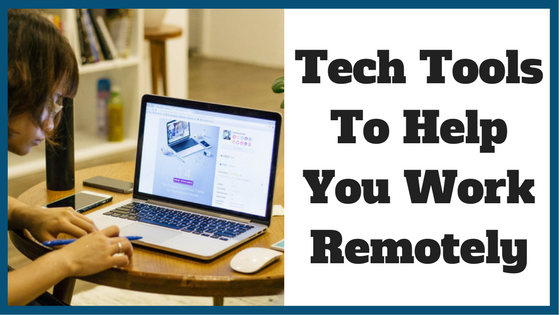- You are here:
- Home »
- Career Advice
- » Tech Tools To Help You Work Remotely
Tech Tools To Help You Work Remotely
Remote working is the future. In 2016, Global Workplace Analytics found that roughly a quarter of the U.S. workforce telecommutes with some degree of frequency, while a whopping 80-90% would like to. Employers have heard their pleas; teleworking is on the rise, with many companies offering home-based options for staff.
While remote working holds obvious benefits for both employer and employee – including increased productivity, improved turnover and reduced absenteeism – it comes with certain caveats. In a world where workplace transparency is key, it can be hard to ensure that a teleworker is hitting targets. Collaboration becomes difficult when colleagues work all over the world and even the most iron-willed freelancer can find self-management challenging.
Fortunately, there are technological solutions to all these issues. Here are the best online tools to get you speeding on your telecommute.
Speedy internet connection
The first and most essential thing you need to succeed in teleworking is a fantastic internet connection. It’s no use having that edit ready for 9 AM if you can’t actually get it to the client.
For those working from home, a fail-safe broadband is a must. Tempting as it might be to opt for the cheapest plan available; for a few extra dollars a month you can often double your download speed and increase your upload by far more. The most important thing of all is to ensure you’ll suffer minimal connection failure. Do your research on complaint rates for the major providers in your area and decide accordingly.
If your internet does go down, or if you’re planning on traveling a great deal, you’re going to need a back-up plan. Migrating from coffee shop to coffee shop in search of a free public router doesn’t exactly scream professional. Get yourself a portable router like the Karma Go; for a minimal fee, you can subscribe to a certain number of gigabytes per month, or simply opt for pay-as-you-go. Alternatively, subscribe to Wifi hotspot services like At&T Wi-Fi (Shaw Go WiFi for Canada and BT-Wifi-With-Fon for UK). Bye-bye lame ‘my broadband died’ excuses.
Last, but not least, if you’re a freelancer you’re going to need a professional email. That tween1999@hotmail address you coined at thirteen won’t cut it; neither will your personal gmail account if it’s not your full name. If you have a website, use a custom domain, e.g. ‘kat@katsheridan.com’. Ensure your display name is your own, spelled out in full; you don’t want ‘KitKat Muncher’, or even just ‘Kat’, coming up on contact lists. Finally, ensure that the address displayed on your site is generalized even further – for example, info@katsheridan.com. You can then set up a forward to your personal account if you’re the only person working in your business.
Storage
Google Drive remains a fantastic way to share and store files online in an easily accessible space. But what if you need additional reassurance for your work? SugarSync can offer options to backup files on your computer, linked with folders and sync documents via email. DropBox is another great option for sharing and storing large files.
If security is your concern, SpiderOak ensure that the key to your file encryption is stored with you – so basically, the company itself can’t access your documents. Nice ‘n’ private.
Team management
If you’re working remotely but are still technically operating in a team, it can be difficult to replicate the collaboration possible in an office environment. Video conferencing offers a good solution, allowing colleagues to chat and pass ideas round as if face-to-face. Zoom is a teleworking favourite. It functions on Windows, Mac, iPhone, iPad, Android and BlackBerry. For free you get unlimited one-to-one meetings, plus any number of group meetings up to 40 minutes.
Need a way to keep track of your team? Basecamp, Asana and Trello all offer ways to do this, breaking large to-dos down into smaller subtasks and assigning jobs to various team members.
If you’re looking for something even simpler, IDoneThis allows remote employees to check in, let employers know what they’re working on and tick off completed tasks. It’s a simple way for employees to keep their managers in the loop.
Self management
Freelancer? No sweat. There are plenty of techie ways to get on top of your personal workload.
Harvest is an app that tracks time spent on certain tasks, generates invoices and accurately billing your client. What’s more, it boasts a free plan for individual businesses of one person and up to two projects – perfect for small-time freelancers.
Need a stronger version of the trusty to-do list? Wunderlist is your best bet. You can add anything to a list, set due-dates and reminders, share lists and generally keep track of your goals.
Finally, if all these programs and separate sign-ins are doing your head in, there’s something that can cure the confusion… Another app! Meldium allows you to corral all of your various applications into one place, so that only one log-in is required to access all. Just make sure you remember that password!
So next time you’re up for a home-based role with a company, ask them what kind of tools they use to optimize your output. And remember: the employee who’s accountable is notable… For all the right reasons!
Thinking of hiring a career coach to help you find a great career where you can work from home? Browse our directory of career coaches and get a FREE consultation or request a personalized coach recommendation!
About the Author S
The author has asked to remain anonymous.

